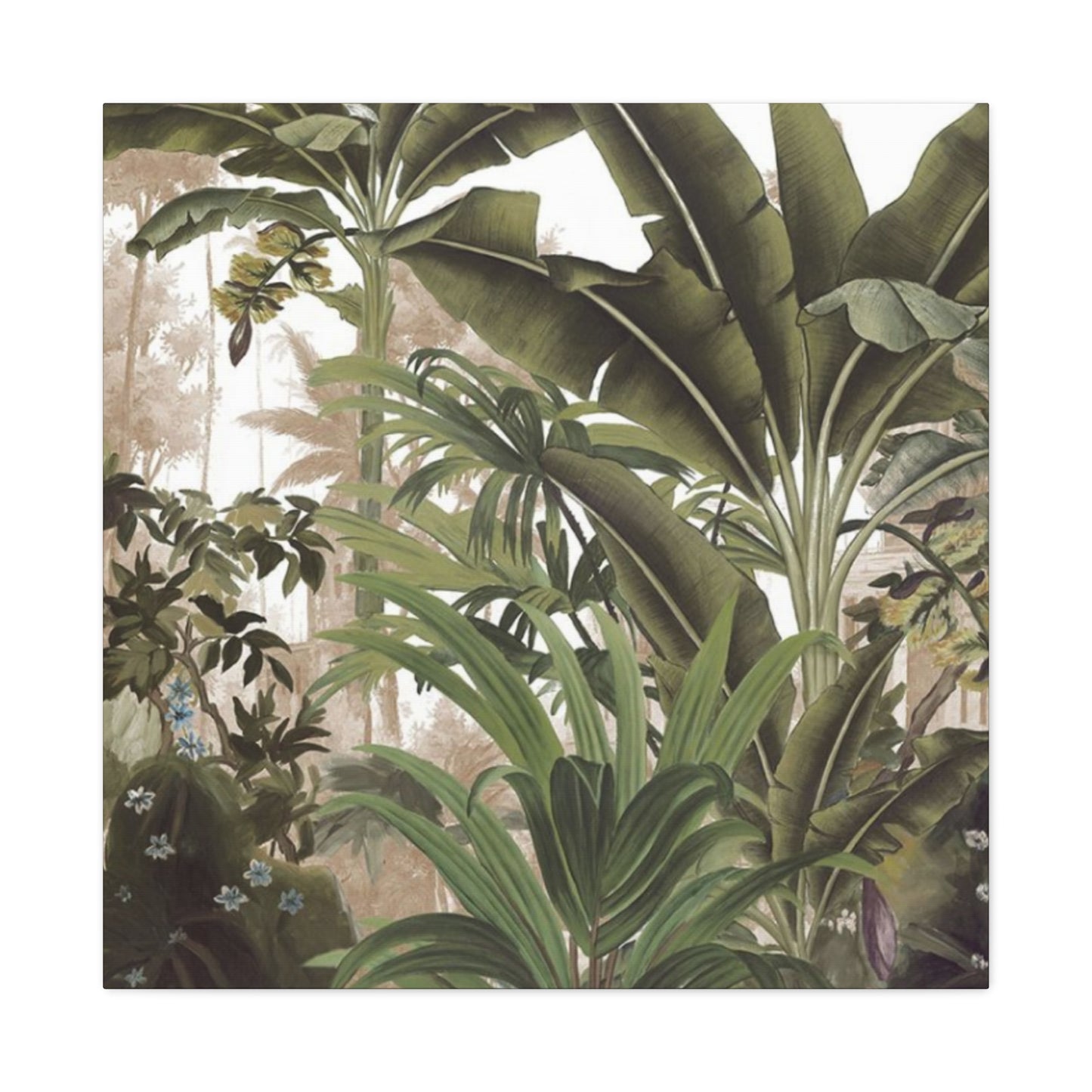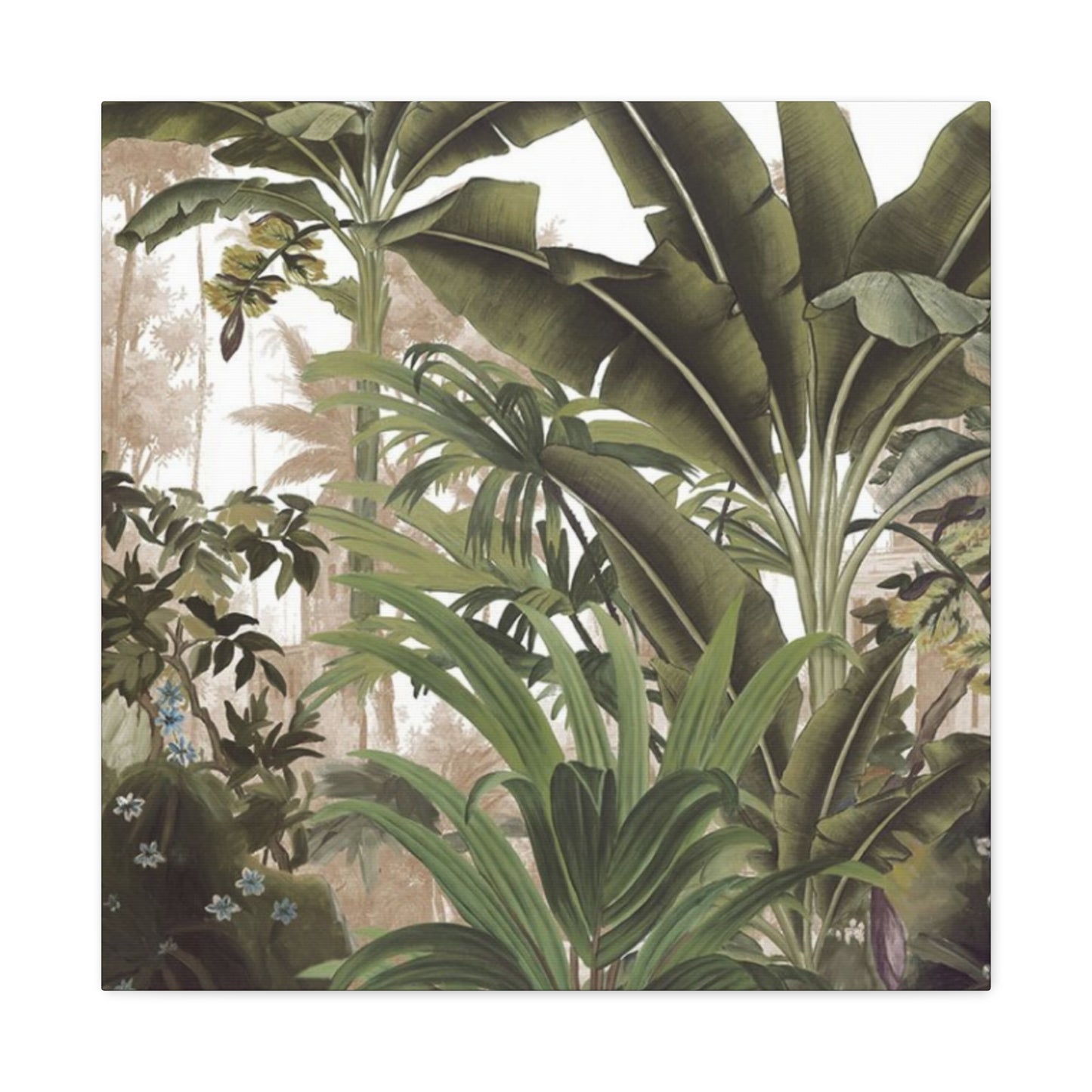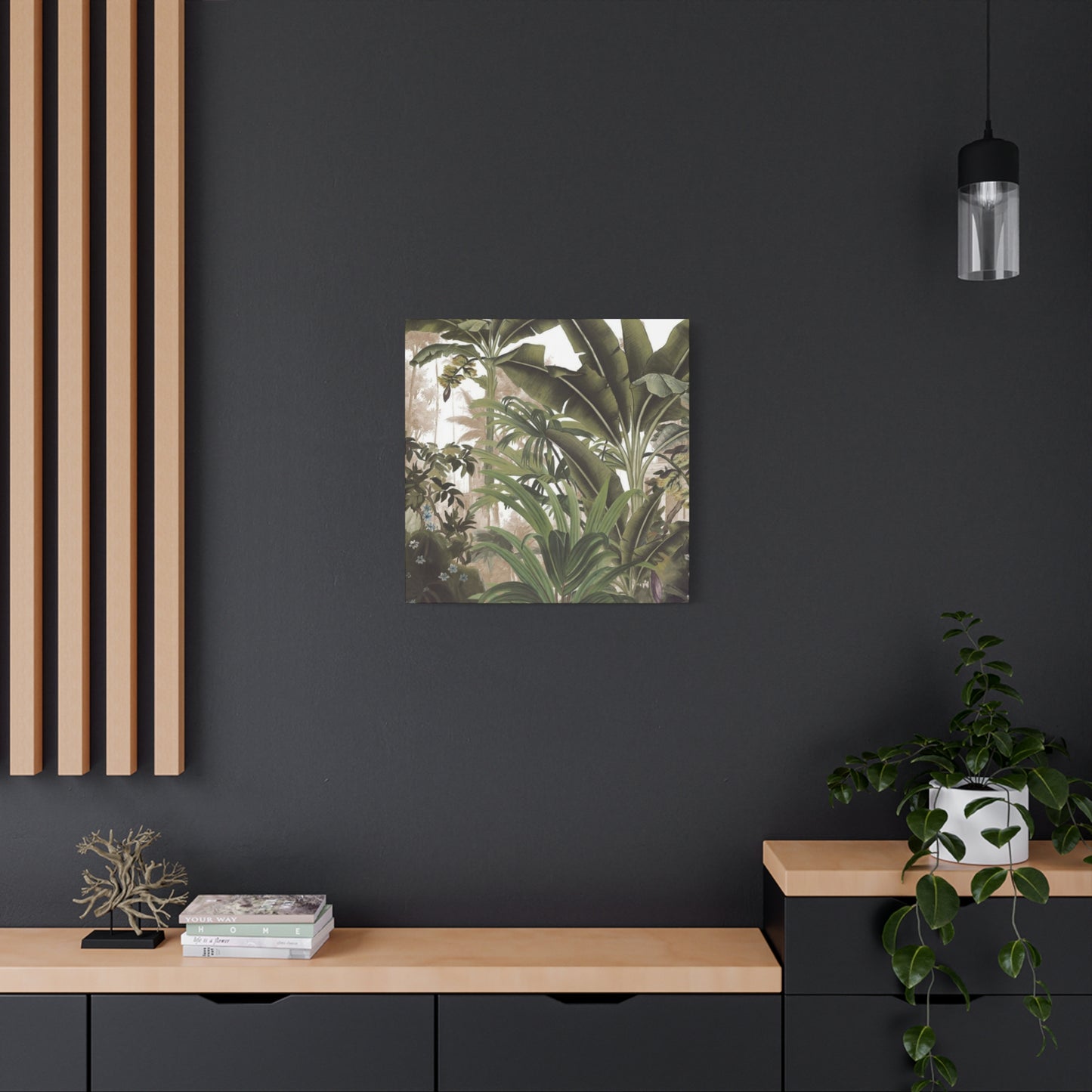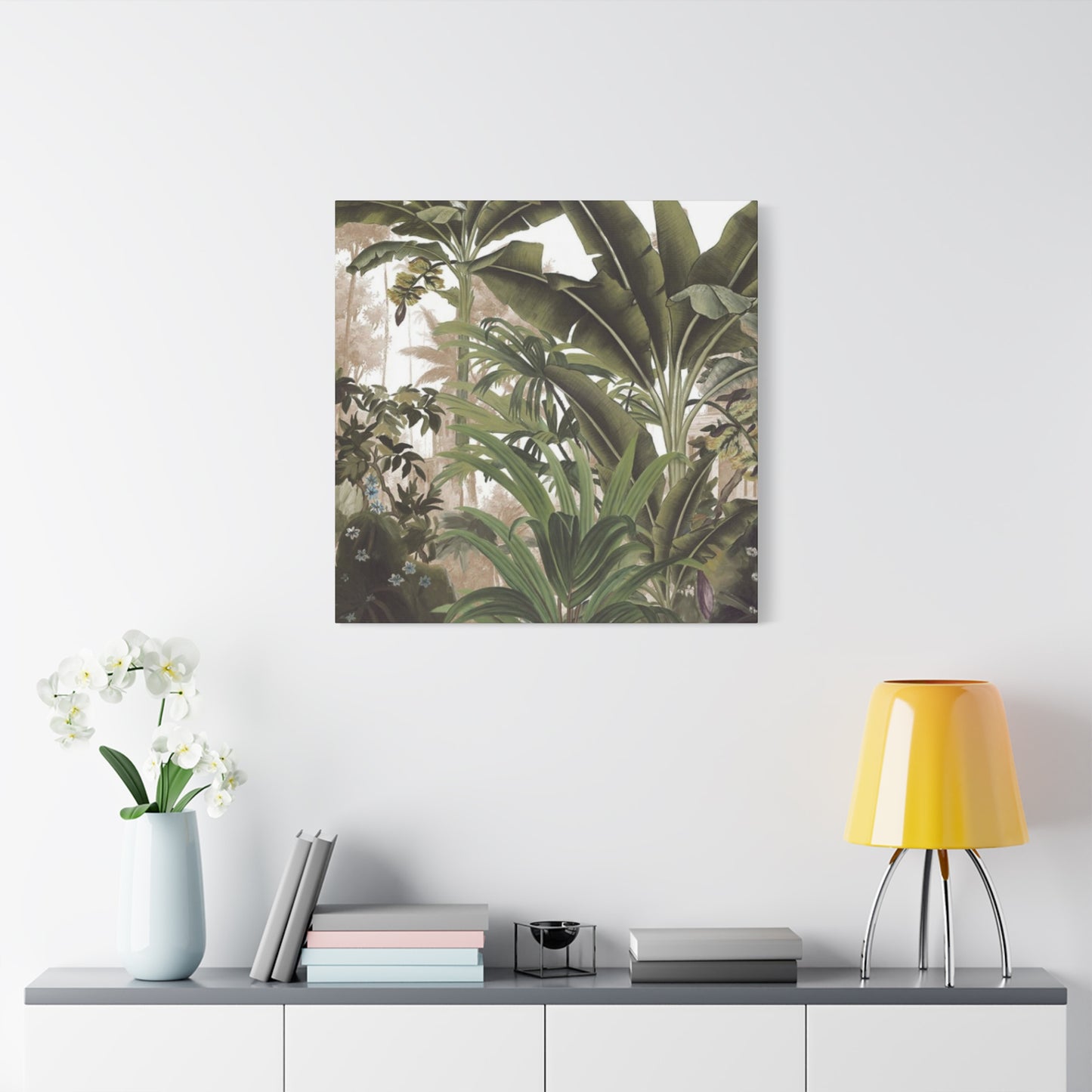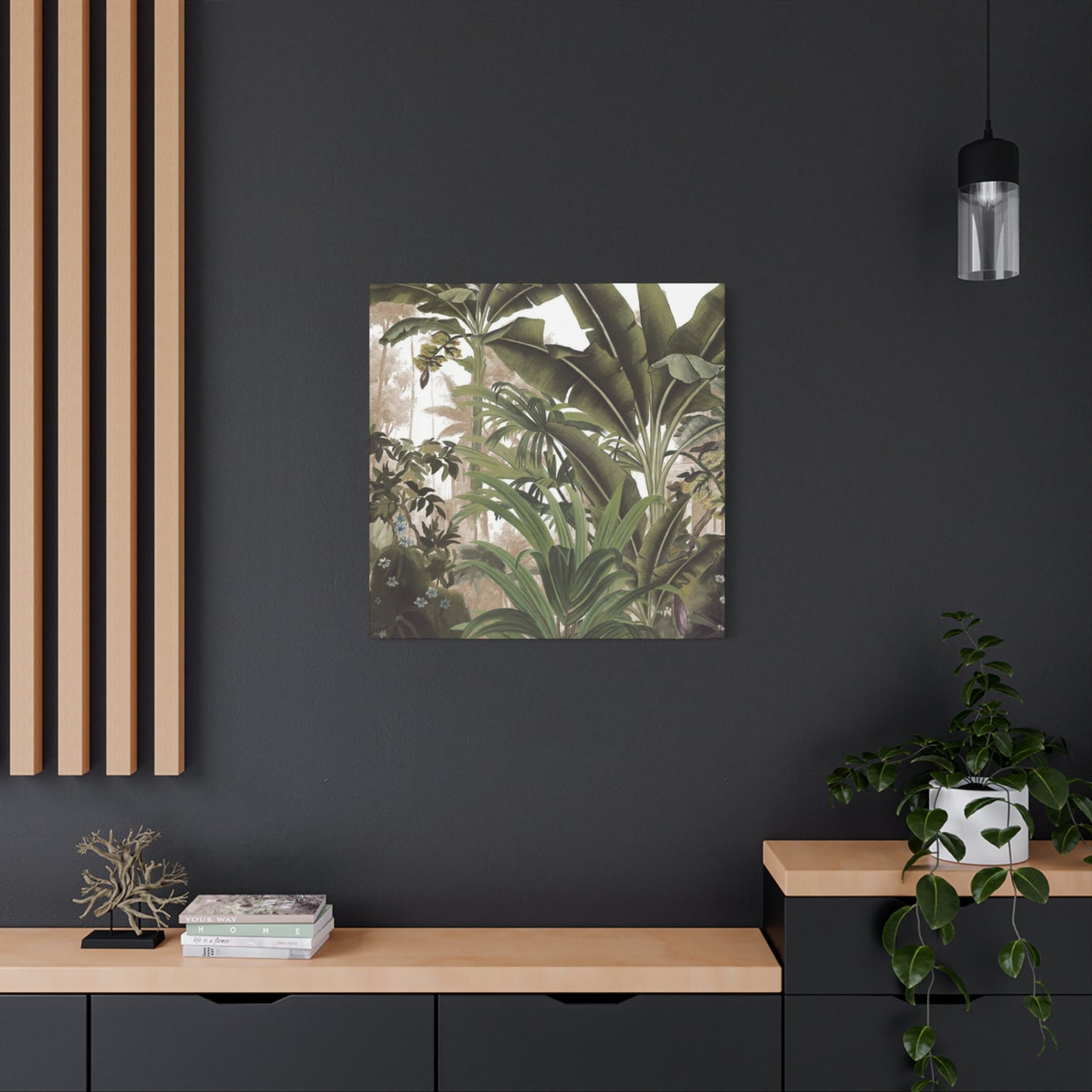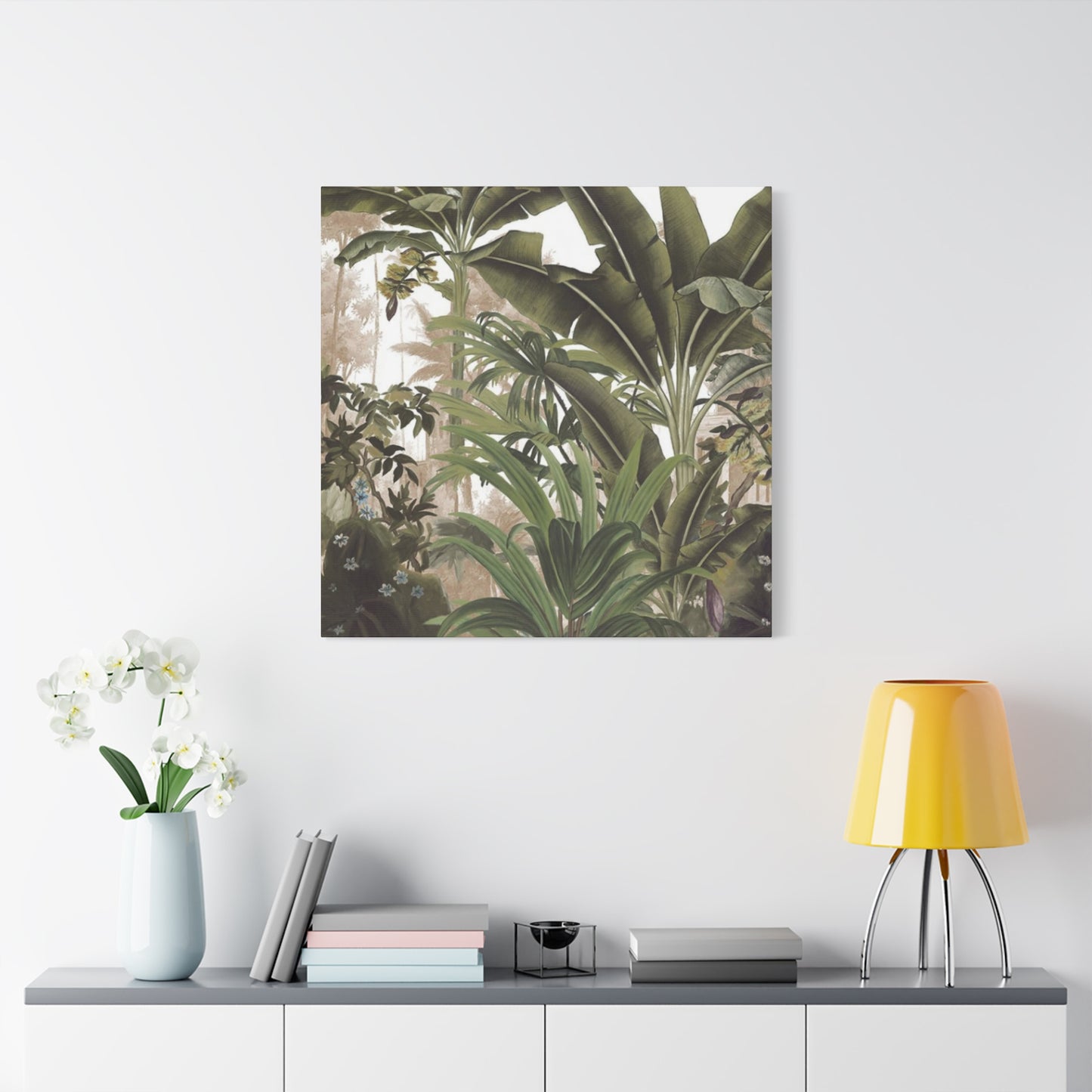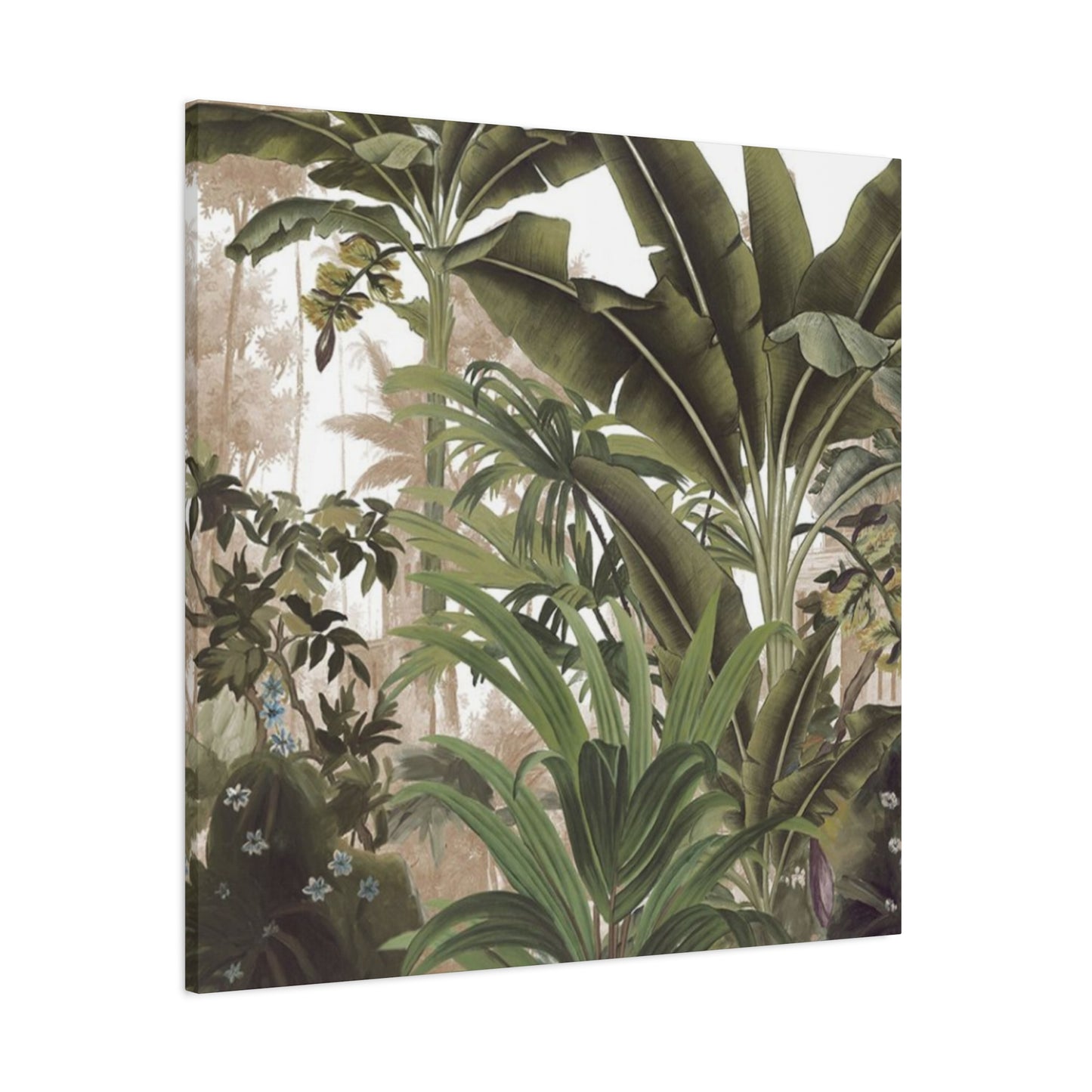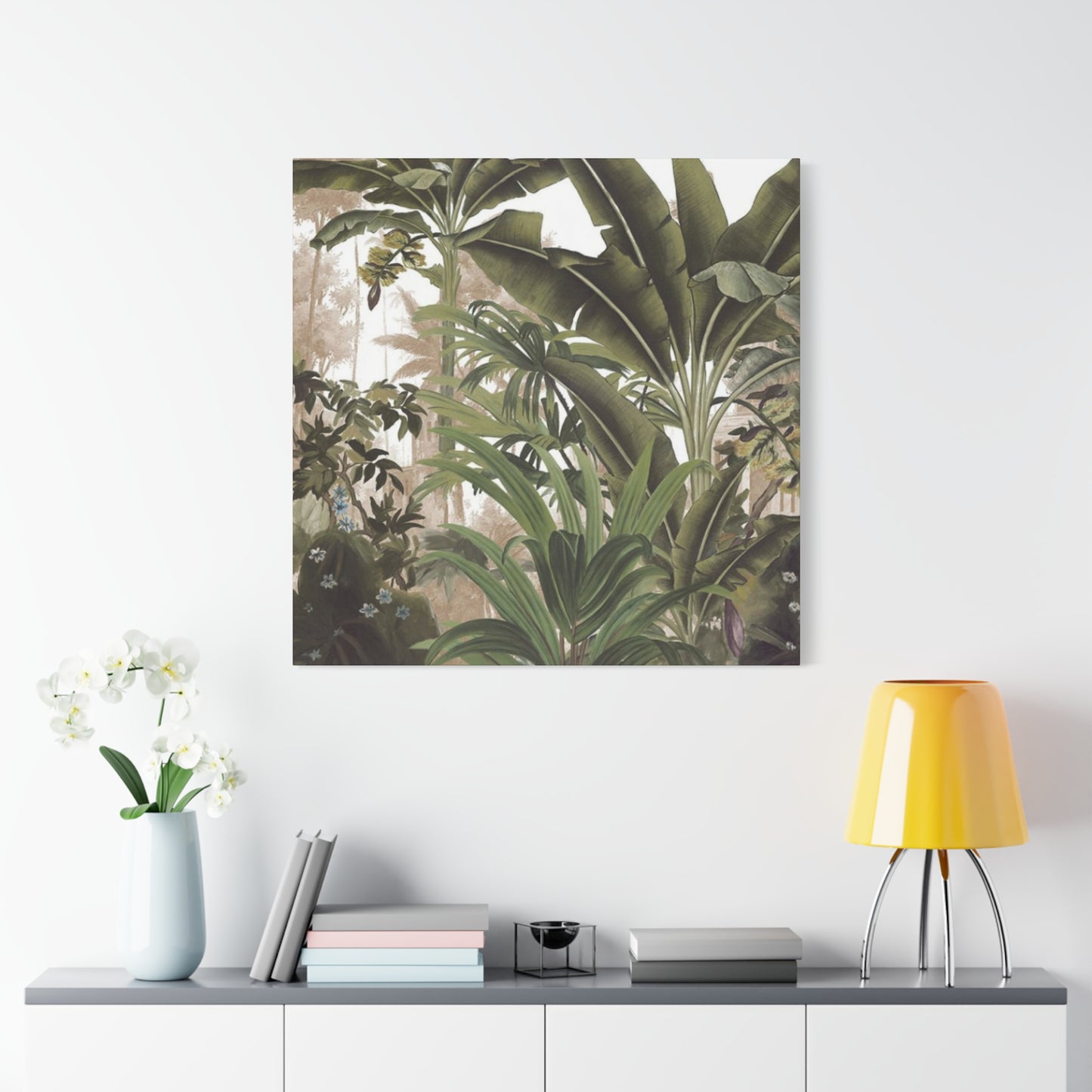How Wildlife Palm Tree Leaves Wall Art Can Create an Exotic, Relaxing Atmosphere
The growing fascination with botanical aesthetics has transformed interior design, creating spaces that blur the boundaries between indoor comfort and outdoor serenity. Canvas wall art featuring lush greenery, sweeping fronds, and dense foliage has emerged as a dominant trend, offering homeowners and designers alike the opportunity to infuse their environments with the vitality and tranquility of natural landscapes. This comprehensive exploration delves into the world of botanical canvas prints, examining their aesthetic appeal, psychological benefits, decorating applications, and the remarkable ways they can transform any room into a personal sanctuary.
Palm Tree Leaves Canvas Wall Art
Canvas prints showcasing the elegant fronds of palm trees have become increasingly popular in contemporary interior design. These artworks capture the graceful curves and dramatic silhouettes of palm leaves, bringing a sense of movement and organic beauty to any wall. The visual appeal of palm fronds lies in their architectural quality, with each leaf displaying intricate patterns of leaflets that radiate from a central stem, creating natural geometric designs that are both complex and harmonious.
When selecting palm tree canvas art, consider how the color palette complements your existing décor. Deep green prints work beautifully in spaces with neutral tones, providing a striking focal point that draws the eye without overwhelming the senses. Lighter, more muted green variations can create a softer, more subtle effect, perfect for bedrooms or meditation spaces where tranquility is paramount. Some prints feature palm leaves against contrasting backgrounds such as white, beige, or even dramatic black, each option creating a distinctly different mood and visual impact.
The scale of palm leaf artwork plays a crucial role in its effectiveness. Large-scale prints featuring a single dramatic frond can serve as a statement piece above a sofa or bed, commanding attention and establishing a bold design aesthetic. Conversely, smaller prints arranged in groups or series can create visual interest through repetition and variation, allowing you to build a gallery wall that tells a cohesive botanical story. The versatility of palm tree canvas art makes it suitable for various room types, from living rooms and bedrooms to home offices and even bathrooms, where the tropical motif can enhance a spa-like atmosphere.
Modern printing techniques ensure that these canvas artworks capture every detail of palm leaves, from the subtle variations in color to the delicate texture of each leaflet. High-quality canvas prints often feature multiple layers of ink, creating depth and dimension that brings the artwork to life. The canvas material itself adds to the organic feel, its texture complementing the natural subject matter and creating a more authentic, less commercial appearance than standard paper prints.
Tropical Wildlife Wall Décor Prints
Incorporating elements of tropical ecosystems into interior spaces creates an immersive experience that transports viewers to distant, exotic locations. Canvas prints that combine lush vegetation with glimpses of wildlife offer a more dynamic and engaging visual narrative than simple botanical studies. These artworks might feature colorful birds perched among leaves, butterflies hovering near blossoms, or other creatures that inhabit tropical regions, adding layers of interest and storytelling to your walls.
The integration of wildlife elements with botanical subjects creates a sense of vitality and movement that purely plant-based artwork cannot achieve. A canvas depicting a vibrant toucan amid dense foliage, for instance, draws the eye through color contrast and the inherent interest humans have in animal life. Similarly, prints featuring exotic butterflies with wings spread against a backdrop of tropical leaves combine natural beauty with scientific precision, appealing to both aesthetic and intellectual sensibilities.
These hybrid artworks work particularly well in spaces designed for relaxation and contemplation. A reading nook adorned with tropical wildlife prints can become a personal escape, a place where the mind can wander to faraway places while the body remains comfortably at home. Children's rooms also benefit from these dynamic prints, as the combination of plants and animals stimulates imagination and fosters an appreciation for the natural world. Educational settings, from home-schooling areas to professional classrooms, can use these prints to spark conversations about ecosystems, biodiversity, and environmental conservation.
When selecting wildlife-enhanced botanical prints, consider the color intensity and overall composition. Some prints feature bold, saturated colors that create dramatic visual impact, perfect for contemporary spaces with minimalist furnishings that allow the artwork to take center stage. Others employ more subdued, naturalistic color palettes that blend seamlessly with traditional or transitional décor styles. The level of detail also varies significantly, from highly realistic renderings that capture every feather and vein to stylized, artistic interpretations that emphasize form and color over photographic accuracy.
Quality considerations for these prints include color accuracy and longevity. Look for canvas artwork produced with fade-resistant inks that will maintain their vibrancy even when exposed to indirect sunlight. The canvas stretching technique also matters; properly gallery-wrapped canvases have the image continuing around the edges, eliminating the need for framing and creating a more modern, clean-lined appearance. The depth of the stretcher bars, typically ranging from three-quarters of an inch to two inches, affects how the artwork projects from the wall, with deeper stretchers creating a more three-dimensional, sculptural presence.
Jungle Leaves Canvas Wall Art
Dense, layered compositions featuring multiple types of jungle foliage create visual richness that draws viewers into the artwork. Unlike prints focusing on a single plant species, jungle leaf canvases capture the abundant diversity of tropical forests, where countless plants compete for sunlight, creating overlapping layers of texture and color. These complex compositions reflect the actual structure of rainforest canopies, where different species occupy various vertical layers, each adapted to specific light conditions and ecological niches.
The aesthetic appeal of jungle leaf artwork lies in its ability to suggest depth and dimension. Through careful arrangement of leaves at different scales and with varying degrees of detail, artists create the illusion of looking into a three-dimensional space rather than at a flat surface. Leaves in the foreground might display sharp detail and saturated color, while those receding into the background become progressively softer and more muted, mimicking the atmospheric perspective that occurs naturally in dense forests. This technique engages the viewer's eye, encouraging visual exploration as different elements reveal themselves upon repeated viewing.
Color variation within jungle leaf prints ranges from nearly monochromatic studies in various shades of green to more diverse palettes incorporating yellows, browns, and even touches of red or purple from flowers or new growth. The choice between these approaches depends largely on the existing color scheme of your space. A room with many competing colors might benefit from a more restrained, green-focused print that provides visual respite, while a neutral space could be energized by artwork featuring greater color diversity.
The emotional response to jungle foliage artwork tends toward feelings of adventure, vitality, and connection with untamed nature. Unlike the elegance of single palm fronds or the serenity of minimalist botanical prints, jungle compositions suggest the energy and abundance of thriving ecosystems. This makes them particularly suitable for spaces where you want to inspire creativity and activity, such as home offices, studios, or exercise areas. The visual complexity stimulates the mind without creating stress, offering the kind of interesting-but-not-overwhelming stimulation that can actually enhance focus and productivity.
Installation considerations for jungle leaf prints include viewing distance and lighting. These complex compositions benefit from being viewed from a moderate distance, where the eye can take in the entire composition rather than getting lost in individual elements. Proper lighting enhances the depth effect, with angled light creating shadows that accentuate the layered quality of the image. Avoid placing these prints in locations with harsh, direct lighting that might flatten the image or create unwanted glare on the canvas surface.
Exotic Palm Canvas Wall Décor
The term exotic encompasses plants with unusual forms, striking colors, or distinctive characteristics that set them apart from common varieties. Canvas art featuring exotic palm species showcases the remarkable diversity within the palm family, moving beyond familiar fan palms and coconut palms to highlight less common varieties with unique aesthetic qualities. These might include palms with red or orange fronds, species with unusual growth patterns, or varieties featuring distinctive trunk textures or crown shapes.
Exotic palm artwork often emphasizes the architectural qualities of these plants, highlighting their structural beauty and geometric perfection. The symmetry inherent in palm crown formation, where fronds radiate outward from a central growing point, creates naturally balanced compositions that are pleasing to the human eye. Some prints capture this symmetry through aerial or upward-looking perspectives, showing the perfect radial arrangement of leaves against a sky background. Others focus on the textural qualities of palm trunks, with their distinctive patterns of leaf scars, fiber matting, or smooth, ringed surfaces.
The color palette of exotic palm prints can vary dramatically depending on the species featured and the artistic treatment. Natural greens remain predominant, but the addition of unusual elements such as the bright orange new growth of certain palm species or the silvery-blue tones of desert varieties adds unexpected color notes that can tie the artwork to other elements in your décor. Some artists apply creative color treatments, rendering palms in sepia tones for a vintage look, black and white for dramatic contrast, or even unexpected hues like teal or rose for a contemporary, artistic interpretation.
These prints work particularly well in modern and contemporary interiors where clean lines and uncluttered spaces allow the artwork's inherent structure to shine. A single large-scale print of an exotic palm can anchor a minimalist room, providing organic interest without disrupting the spare aesthetic. In more eclectic spaces, exotic palm prints can be mixed with other botanical artwork to create a curated collection that suggests a well-traveled collector with refined tastes.
The choice between photographic and illustrated styles affects the overall impact of exotic palm artwork. Photographic prints offer realism and detail that allows viewers to appreciate the actual appearance of these remarkable plants, making them suitable for spaces with a natural history or scientific aesthetic. Illustrated versions, whether watercolor, digital painting, or line drawing, emphasize artistic interpretation over documentation, resulting in work that feels more decorative and less literal, often better suited to fashion-forward or design-conscious interiors.
Tropical Leaves Canvas Wall Prints
Broadening beyond palms to encompass the full spectrum of tropical foliage opens up remarkable variety in terms of leaf shapes, sizes, and textures. Tropical environments produce some of the most dramatic foliage on the planet, from the enormous, fenestrated leaves of monstera plants to the delicate, compound fronds of ferns, from the broad, paddle-like leaves of bird of paradise plants to the intricate, colorful patterns of croton and calathea. Canvas prints featuring this diverse foliage offer endless possibilities for personal expression and interior design experimentation.
The visual vocabulary of tropical leaves is remarkably rich. Smooth, glossy surfaces reflect light differently than matte, textured ones. Solid leaves create bold shapes and strong shadows, while divided or perforated leaves like those of philodendrons create intricate patterns of positive and negative space. Variation in leaf edges, from perfectly smooth to deeply serrated, adds another dimension of visual interest. Artists and photographers working with tropical foliage can emphasize any of these qualities, creating artwork that ranges from bold and graphic to soft and subtle.
Color plays a crucial role in tropical leaf artwork, extending far beyond simple greens. Many tropical plants feature leaves with variegation, displaying patterns of white, cream, yellow, pink, or red alongside green. Others have deep purple or burgundy foliage, while some species feature leaves with metallic sheen or iridescent qualities. Canvas prints can capture these color variations with remarkable fidelity, allowing you to introduce unexpected color notes into your space through seemingly simple botanical artwork.
The arrangement and composition of tropical leaf prints significantly affects their visual impact. Single-leaf studies, where one large leaf fills the frame, create bold, graphic statements that work well in modern spaces with simple furnishings. Multi-leaf compositions, showing several leaves overlapping or arranged in patterns, offer more visual complexity and work well in larger spaces or as part of gallery wall arrangements. Some prints feature tropical leaves arranged in artificial patterns, such as symmetrical designs or repeating motifs, creating a more decorative, pattern-like effect.
Styling tropical leaf prints requires consideration of both the artwork itself and its surroundings. These prints pair naturally with natural materials like wood, rattan, jute, and linen, creating a cohesive organic aesthetic. They also work surprisingly well with metal accents, particularly brass or copper, which adds warmth without competing with the organic forms of the foliage. In terms of color coordination, tropical leaf prints can either complement existing colors by picking up green tones present in upholstery or accessories, or they can provide contrast, introducing organic elements into predominantly neutral or cool-toned spaces.
Wildlife-Inspired Palm Tree Wall Art
The intersection of wildlife and botanical elements in canvas art creates layered narratives that engage viewers on multiple levels. Palm trees serve as habitat and food source for numerous species, from birds and mammals to insects and reptiles, making them natural focal points for wildlife activity in tropical environments. Artwork that captures these relationships tells stories about ecosystems and interconnection, moving beyond simple decoration to create pieces with deeper meaning and educational value.
The compositional challenges of combining wildlife with palm trees require careful balance between competing visual elements. The strong vertical lines and radiating forms of palm fronds can either complement or compete with animal subjects, depending on how the artist handles scale, placement, and visual weight. Successful compositions often use the palm tree as a framing device, with fronds creating natural borders or directional lines that guide the viewer's eye toward the wildlife subject. Alternatively, the animal might be integrated into the palm's structure, perched on fronds or climbing the trunk, creating a sense of discovery as viewers notice the creature within the larger composition.
Species selection affects the mood and message of wildlife-enhanced palm artwork. Bright tropical birds like parrots or toucans create cheerful, energetic pieces that work well in social spaces or children's rooms. More subtle subjects like lizards, tree frogs, or smaller birds create compositions that reward closer inspection, perfect for studies or reading areas where artwork is viewed at closer range. Larger animals like monkeys or sloths add a sense of playfulness or tranquility respectively, with each species bringing its own associations and emotional resonances.
These hybrid artworks bridge multiple interior design styles. In tropical or coastal-themed rooms, they reinforce the overall aesthetic while adding depth and interest. In more eclectic spaces, they can serve as conversation pieces that reveal the homeowner's interests and values. Environmental consciousness, love of travel, appreciation for biodiversity, or simply an affinity for the natural world can all be expressed through carefully chosen wildlife and botanical artwork.
The production quality of these prints deserves special attention, as rendering both plants and animals with fidelity requires skill and attention to detail. Look for prints with sharp, clear animal features, accurate coloration, and realistic interaction between the wildlife and its environment. The animal should appear naturally integrated into the scene rather than awkwardly superimposed, with appropriate lighting, scale, and perspective creating a coherent and believable image.
Lush Jungle Canvas Wall Décor
Creating the impression of lush, abundant vegetation requires both compositional skill and technical excellence. The most effective jungle-themed canvas art captures not just the appearance of individual plants but the feeling of being surrounded by thriving, vigorous plant life. This sense of abundance comes through careful layering, with multiple planes of foliage creating depth, and through attention to the small details that make vegetation look alive rather than static – the curl of a new frond, the play of light through overlapping leaves, the subtle variations in color that indicate different stages of growth.
The psychological impact of lush jungle imagery relates to biophilic design principles, which recognize humans' innate connection to nature and natural processes. Surrounding ourselves with images of thriving ecosystems can reduce stress, improve mood, and enhance cognitive function, particularly in urban environments where access to actual nature may be limited. Canvas art depicting lush vegetation brings these benefits into homes and workplaces, creating visual connections to the natural world that operate on both conscious and subconscious levels.
Scale considerations for jungle-themed artwork differ from those for simpler botanical prints. The complexity and density of jungle compositions often benefit from larger formats, where the eye can distinguish individual elements while still appreciating the overall effect of abundance. A small print of dense vegetation may appear cluttered or confusing, while the same composition enlarged to three feet or more allows proper visual breathing room. However, size must be balanced against available wall space and viewing distance to ensure the artwork can be properly appreciated.
Color saturation levels in jungle prints dramatically affect their energy and impact. Highly saturated greens create vibrant, energetic pieces that command attention and inject vitality into a space. More muted, desaturated versions of similar compositions create a calmer, more contemplative effect, perfect for spaces designed for relaxation rather than stimulation. Some prints employ monochromatic or near-monochromatic green palettes, finding variety through different shades and tones rather than introducing other colors, while others incorporate flowers, fruits, or sky glimpses that add color contrast.
Framing and presentation options for jungle-themed canvas art include both traditional stretched canvas and newer formats like floating frames or panel mounting. Stretched canvas with gallery wrapping offers a contemporary, frameless look that emphasizes the image itself. Floating frames add a finished quality while maintaining the modern aesthetic, suspending the canvas within a frame that doesn't touch the edges of the image. Panel mounting creates the flattest profile, adhering the canvas to a rigid backing for a sleek, contemporary appearance. Each option affects how the artwork relates to its wall and surrounding décor.
Green Palm Leaves Canvas Wall Prints
The color green itself carries significant psychological associations, linked to growth, renewal, harmony, and nature. Canvas prints focusing specifically on the various shades and tones of green found in palm leaves tap into these positive associations, creating artwork that is both aesthetically pleasing and emotionally beneficial. The range of greens in palm foliage extends from the bright, yellow-tinged green of new growth to the deep, blue-tinged green of mature fronds, offering more variety and visual interest than might initially be apparent.
Monochromatic green compositions, despite their limited color range, can display remarkable complexity through variations in value, saturation, and temperature. Light greens advance visually while darker greens recede, creating depth without relying on perspective or scale differences. Warm greens, those with yellow undertones, convey energy and vitality, while cool greens with blue undertones suggest tranquility and stability. Artists working with palm leaf imagery can manipulate these subtle variations to create specific moods and visual effects, making seemingly simple green prints surprisingly sophisticated.
The interplay between green palm leaf artwork and interior color schemes offers numerous possibilities. In spaces dominated by warm neutrals like beige, tan, or warm gray, green palm prints provide complementary color contrast that enlivens without clashing. Against cool neutrals like true gray or white, green artwork adds warmth and organic energy. In rooms with existing green elements in upholstery or accessories, palm leaf prints in coordinating shades create cohesive, harmonious environments. Even in colorful spaces, green acts as a neutral that bridges other hues, grounding the palette.
Lighting dramatically affects how green tones are perceived and should be considered when selecting and placing palm leaf prints. Natural daylight brings out the truest colors, showing subtle variations in tone and saturation. Warm artificial light from incandescent or warm LED bulbs enhances yellow undertones in greens, making them appear more vibrant and alive. Cool artificial light from daylight-balanced or cool LED bulbs emphasizes blue undertones, creating a calmer, more serene effect. Adjusting lighting or selecting prints with this in mind ensures your artwork looks its best in its intended location.
Texture plays an important supporting role in green palm leaf prints, adding visual interest to compositions that might otherwise feel flat. The canvas weave itself provides subtle texture, but printing techniques that layer inks or use specialized coatings can enhance this quality. Some prints feature glossy areas that catch light, mimicking the natural sheen of healthy palm fronds, while matte areas create contrast and depth. These textural variations, though subtle, add to the overall richness of the artwork and its ability to maintain visual interest over time.
Tropical Forest Canvas Wall Art
Expanding the view to encompass entire forest scenes rather than focusing on individual plants creates artwork with narrative and immersive qualities. Tropical forest canvas prints might depict understory views looking up toward the canopy, forest paths winding through dense vegetation, stream or waterfall settings surrounded by lush growth, or aerial perspectives showing the textured carpet of treetops. Each viewpoint offers different compositional opportunities and creates distinct emotional responses.
The sense of place created by tropical forest artwork can transport viewers to specific environments, from misty cloud forests to sun-drenched lowland rainforests, from dense Amazonian jungles to more open tropical woodlands. This specificity appeals to those who have visited such places and wish to preserve memories of their travels, as well as to those who dream of future adventures or simply appreciate the beauty of distant ecosystems. The artwork becomes a window to another world, offering visual escape and mental refreshment.
Compositional elements in forest scene prints include not just plants but also light, atmosphere, and space. The quality of light filtering through a forest canopy, creating dappled patterns on the forest floor or illuminating mist, adds drama and dimension to these images. The treatment of atmospheric perspective, where distant elements become hazier and less distinct, creates convincing depth that draws viewers into the scene. The inclusion of negative space, whether patches of sky visible through the canopy or areas of shadow and darkness, prevents compositions from feeling overwhelmingly busy despite their complexity.
These expansive forest views work particularly well in larger rooms where they can be viewed from a distance that allows the eye to take in the entire scene. Living rooms, open-concept spaces, and offices with ample wall space can accommodate large-scale forest prints that create dramatic focal points. Multiple related prints can be arranged in series, creating panoramic effects that extend across entire walls, particularly effective in long, narrow spaces like hallways or above credenzas and console tables.
The balance between realism and artistic interpretation varies among tropical forest prints. Photographic images offer documentary accuracy and can showcase specific locations or rare species, appealing to nature enthusiasts and travelers. Painted or illustrated versions allow for artistic license, emphasizing certain elements, simplifying others, or manipulating colors for heightened effect. Both approaches have merit, with the choice depending on personal preference and the overall design aesthetic of the space.
Exotic Leaves Canvas Wall Décor
The category of exotic leaves encompasses species with unusual characteristics that distinguish them from common houseplants and garden varieties. These might include plants with dramatic fenestrations like Swiss cheese plants, species with colorful variegation such as calatheas and prayer plants, plants with unusual textures like velvet-leaf anthuriums, or varieties with striking forms such as the paddle-shaped leaves of certain tropical trees. Canvas art featuring these exceptional specimens appeals to plant enthusiasts and design-conscious individuals seeking distinctive, conversation-worthy wall décor.
The graphic quality of many exotic leaves makes them particularly suitable for modern and contemporary interiors. Bold shapes and strong lines create visual impact without requiring busy patterns or multiple colors. A single fenestrated monstera leaf, for instance, creates an instantly recognizable silhouette with inherent visual interest derived from its natural perforations. The stark contrast between the solid leaf material and the open holes creates a dynamic interplay of positive and negative space that engages the viewer's eye.
Color treatments for exotic leaf artwork range from naturalistic renderings that capture actual plant coloration to highly stylized versions in unexpected hues. Photographic prints might show the burgundy underside of a ficus leaf, the silver markings on a scindapsus, or the pink and green variegation of a tradescantia. Artistic interpretations might render leaves in metallic tones, pastel palettes, or even neon brights, transforming botanical subjects into contemporary art pieces that happen to be nature-inspired rather than strictly naturalistic.
The educational aspect of exotic leaf artwork appeals to those interested in botany, horticulture, or natural history. Detailed prints that accurately render specific species can serve as both décor and reference, satisfying curiosity about plant morphology and diversity. Labels or accompanying text identifying species, though not printed on the artwork itself, can be included in framing or as separate wall text for those who wish to emphasize the educational dimension of their botanical art collection.
Pairing exotic leaf prints with actual living plants creates layered, multi-dimensional botanical displays. The artwork provides year-round greenery and can feature species that are difficult to grow indoors, while living plants add three-dimensionality, texture, and the dynamic quality of growing, changing organisms. This combination satisfies the desire for botanical abundance even in spaces with limited conditions for plant growth, such as rooms with insufficient natural light or in homes of those without the time or inclination for extensive plant care.
Palm Canopy Canvas Wall Prints
Looking upward into palm crowns from below creates dramatic perspectives that emphasize the architectural beauty and radial symmetry of these plants. Canvas prints capturing this upward view often feature the palm fronds radiating outward from a central point, creating natural mandala-like patterns that are both orderly and organic. The sky visible between the fronds adds color contrast and enhances the sense of space and openness, while the converging perspective lines draw the viewer's eye into the composition.
The sense of expansiveness created by canopy views makes them particularly effective in spaces that feel cramped or closed-in. A palm canopy print can visually open up a room, creating the illusion of overhead space and outdoor connection even in windowless areas or basement rooms. The upward orientation naturally draws the eye upward, which can make ceilings appear higher and rooms feel more spacious, a valuable trick in spaces with low ceilings or heavy furnishings.
Lighting conditions depicted in canopy prints significantly affect their mood and energy. Bright, sunny scenes with clear blue skies create cheerful, energizing artwork appropriate for active spaces like living rooms, kitchens, or home gyms. Softer light conditions, such as overcast skies or the golden glow of sunrise or sunset, create more contemplative pieces suited to bedrooms or meditation spaces. Backlit fronds, where the sun shines through the leaves from behind, create luminous, almost ethereal effects with glowing greens and dramatic contrast.
The choice between centered and off-center compositions affects visual dynamics. Perfectly centered canopy views with symmetrical frond arrangements create calm, balanced designs with meditative qualities. Off-center compositions with asymmetrical arrangements introduce tension and movement, creating more dynamic and energizing artwork. The degree of sky visible also matters – compositions with fronds filling most of the frame emphasize the palms themselves, while those with substantial sky areas create a greater sense of openness and atmosphere.
These prints work exceptionally well in vertical formats that echo the upward orientation of the view. Tall, narrow canvases emphasize the verticality and height, while square formats contain the radial pattern more completely. Multiple canopy prints arranged vertically can create the impression of looking up through successive layers of canopy, interesting for stairwells or other vertical spaces. Horizontal arrangements of canopy prints work well above long pieces of furniture, with each print offering a slightly different perspective or showing different palm species.
Nature-Inspired Tropical Canvas Art
The nature-inspired category encompasses artwork that captures the essence and feeling of tropical environments without necessarily reproducing them with photographic accuracy. These pieces might employ artistic license in terms of color, composition, or detail, prioritizing aesthetic impact and emotional resonance over documentary precision. This approach allows for greater creative freedom and can result in artwork that is more versatile and easier to integrate into various design schemes.
Abstracted tropical motifs, where recognizable elements like leaves or fronds are simplified or stylized, bridge the gap between representational art and pure abstraction. These pieces retain enough visual connection to their natural inspiration to read as botanical or tropical, but their simplified forms and often enhanced colors give them a contemporary, design-forward appearance. This makes them particularly suitable for modern interiors where overtly realistic botanical art might feel incongruous with the overall aesthetic.
Color palette experimentation distinguishes many nature-inspired pieces from more literal botanical prints. While maintaining recognizable tropical forms, artists might employ unexpected color combinations – purple and orange, teal and coral, black and gold – that create striking visual effects while still suggesting tropical abundance. These color choices allow the artwork to coordinate with specific interior color schemes or to introduce desired accent colors in a way that feels organic and justified by the subject matter.
The balance between pattern and picture varies across nature-inspired tropical art. Some pieces lean heavily toward pattern, with repeated motifs creating allover designs similar to wallpaper or textiles. Others maintain a stronger sense of pictorial space and composition, with distinct foreground and background elements and a clear focal point. The pattern-oriented approach works well in sets or series, where multiple prints create visual rhythm and coherence, while pictorial pieces often stand alone as individual statement works.
Mixed media approaches, though not possible in standard canvas prints, inspire artistic effects that can be simulated through printing techniques. The appearance of layered papers, applied gold leaf, gestural brushwork, or collaged elements can be captured photographically and reproduced on canvas, creating prints with visual richness and textural interest that transcends simple photographic reproduction. These effects add depth and complexity, making the artwork feel more handcrafted and unique despite being a printed reproduction.
Jungle Foliage Canvas Wall Décor
Dense, intricate jungle foliage compositions challenge both artists and viewers, requiring skill to create and attention to appreciate. The layered complexity of overlapping leaves, vines, and branches creates visual richness that reveals itself progressively, with new details emerging upon repeated viewing. This quality makes jungle foliage artwork particularly suitable for spaces where people spend extended time, such as home offices, studios, or reading areas, where the art can be contemplated at length rather than merely glanced at in passing.
The representation of depth in jungle foliage prints involves multiple visual strategies. Overlapping elements establish basic spatial relationships, with leaves or branches in front obscuring those behind. Scale variation, where closer elements appear larger and more detailed while distant ones become smaller and less distinct, reinforces depth perception. Color temperature shifts, with warmer, more saturated colors advancing and cooler, grayer colors receding, add another layer of spatial information. Atmospheric effects, such as mist or haze making distant foliage less distinct, complete the illusion of three-dimensional space on a two-dimensional surface.
The rhythm and flow of jungle compositions guide the viewer's eye through the artwork. Curving vines or leaning stems create directional lines that lead from one area to another. Repeated shapes or colors establish visual connections across the composition. Areas of rest, where complexity diminishes or negative space appears, provide visual respite and prevent the composition from becoming exhausting to view. Skilled artists balance complexity with clarity, creating rich, detailed work that remains accessible and enjoyable rather than overwhelming.
The sensory quality of jungle foliage prints extends beyond the purely visual. Viewers often report that these images evoke other sensory memories – the humidity and warmth of tropical environments, the sounds of rustling leaves or distant wildlife, even the distinctive smell of dense vegetation. This synaesthetic response deepens engagement with the artwork, making it more memorable and emotionally resonant. The psychological term for this phenomenon is cross-modal association, where stimulation in one sense triggers responses in others based on previous experience.
Installation in interior spaces benefits from considering how jungle foliage artwork affects the perception of the room itself. In small spaces, these dense compositions can make rooms feel even smaller if not carefully chosen, as the visual complexity can seem to close in. However, the same prints in larger rooms with ample breathing room can create cozy, intimate zones within open spaces. The key lies in balancing the artwork's visual weight against the room's dimensions and the amount of other visual information present from furnishings, architectural details, and other decorative elements.
Tropical Vibes Canvas Wall Art
The phrase tropical vibes encompasses more than just visual representation of tropical plants and environments; it refers to an overall feeling or atmosphere of relaxation, vacation, and escape from everyday concerns. Canvas art in this category prioritizes mood and emotional impact over botanical accuracy or detail, often incorporating design elements like vintage filters, retro color palettes, or beach culture references that enhance the vacation-like feeling. This makes it particularly popular for spaces designed for relaxation and unwinding, such as bedrooms, bathrooms, or dedicated leisure areas.
Color plays a central role in creating tropical vibes, with specific palettes evoking different aspects of the tropical experience. Bright turquoise and coral combinations suggest Caribbean beaches and clear waters. Sunset tones of orange, pink, and purple evoke twilight in tropical locations. Vibrant greens with pops of hot pink or yellow reference the lush vegetation and colorful flowers of tropical gardens. Vintage-inspired palettes with faded, sun-bleached colors create nostalgic feelings of old travel posters and retro resort culture.
Typography and text elements appear more frequently in tropical vibes artwork than in purely botanical prints. Motivational phrases, location names, or simple words like paradise, escape, or relax might be incorporated into the design, reinforcing the emotional message and vacation association. The typography style itself contributes to the overall aesthetic, with hand-lettered scripts suggesting casual, beachy informality, while bold sans-serif fonts create a more modern, graphic look. The integration of text must be balanced carefully to enhance rather than overwhelm the visual composition.
The cultural associations of tropical aesthetics have evolved over time, influenced by travel, media, and design trends. Mid-century modern revival has brought renewed interest in the bold, stylized tropical prints of 1950s and 60s design. Tiki culture, despite its problematic appropriative aspects, continues to influence tropical aesthetics with its distinctive visual vocabulary. Contemporary tropical design often attempts to reference the appealing aspects of these historical styles while avoiding cultural insensitivity, focusing on plants and landscapes rather than stereotypical cultural imagery.
Seasonal considerations affect the appeal and appropriateness of tropical vibes artwork. These pieces shine particularly in cold-weather months when their warm, sunny associations provide psychological relief from gray skies and frigid temperatures. However, they can feel excessive or on-the-nose in the height of summer when actual tropical conditions prevail. Some homeowners address this by rotating artwork seasonally, displaying tropical pieces during fall and winter while switching to cooler-toned or less overtly vacation-themed art during warmer months.
Wildlife Jungle Leaves Canvas Prints
The combination of wildlife elements with jungle foliage creates narrative artwork that tells stories about natural habitats and ecological relationships. These prints capture moments of animal behavior within their natural settings, showing how creatures use, navigate, and depend upon the plant life that surrounds them. This approach to canvas art appeals to those interested in nature and wildlife conservation, offering both aesthetic pleasure and subtle environmental messaging.
Species diversity in wildlife-enhanced jungle prints reflects the incredible biodiversity of tropical ecosystems. Prints might feature mammals like jaguars, sloths, or monkeys moving through the canopy, reptiles like iguanas or tree snakes camouflaged among leaves, birds from tiny hummingbirds to large macaws, or insects like butterflies and exotic beetles. The choice of featured species affects the artwork's character – charismatic megafauna create bold, obvious focal points, while smaller or more cryptic creatures reward closer inspection and create discovery moments.
The artistic challenge of integrating wildlife into jungle settings involves balancing competing visual demands. The animal subject needs sufficient visual emphasis to be clearly perceived and identified, yet must also appear naturally integrated into its environment rather than artificially imposed. This balance can be achieved through various means such as directional lighting that highlights the animal while leaving vegetation in relative shadow, color contrast between animal and background, or strategic placement where plant forms frame or direct attention to the wildlife subject.
Educational potential makes wildlife jungle prints particularly valuable in family homes, especially those with children developing their understanding of and appreciation for nature. These images can spark conversations about animal adaptation, camouflage, food chains, habitat requirements, and conservation needs. Parents and educators can use the artwork as a springboard for learning activities, from identifying animals and plants to discussing broader environmental topics. This functional aspect adds value beyond pure decoration, making the artwork an ongoing resource rather than a static object.
Conservation themes implicit in much wildlife-enhanced botanical art align with growing environmental consciousness and concern for threatened species and ecosystems. Many of the animals and plants depicted in such artwork face significant conservation challenges from habitat loss, climate change, and other human impacts. Displaying these images can express values and commitments to environmental protection, and some artwork purchases directly support conservation organizations when artists or publishers donate portions of proceeds to relevant causes.
Lush Green Leaves Wall Art Canvas
Maximizing green tones while maintaining visual interest requires attention to subtle variations in hue, value, and saturation. Lush green leaf artwork celebrates the color itself, using plants as vehicles for exploring the remarkable range of greens found in nature. From the bright, acid green of new growth to the deep, almost black green of shade-adapted leaves, from the blue-tinged green of some palm species to the yellow-green of sun-stressed foliage, the spectrum of natural greens offers far more variety than typically appreciated.
The psychological effects of green environments have been extensively studied, with research consistently showing benefits including stress reduction, improved focus, faster healing, and enhanced creativity. Green is processed most efficiently by human vision, requiring less adjustment and causing less eye strain than colors at either end of the visible spectrum. These physiological factors mean that green-dominated artwork literally creates a more comfortable visual environment, making spaces feel more restful and inviting. This explains the enduring popularity of green botanical art across cultures and time periods.
Texture representation becomes particularly important in green leaf artwork, where color variation alone may not provide sufficient visual interest. The interplay of light and shadow across leaf surfaces, the contrast between glossy and matte areas, the delicate veining that creates subtle patterns, and the three-dimensional quality of leaves that curl or fold all add textural richness. High-quality canvas prints capture these subtle details through multiple ink layers and careful color management, ensuring that the final image maintains the depth and complexity of the original photograph or artwork.
Styling considerations for green leaf artwork include both complementary and contrasting approaches. Complementary styling incorporates additional green elements in textiles, accessories, or living plants, creating an immersive botanical environment. This monochromatic approach can be surprisingly sophisticated when various shades and textures of green are thoughtfully combined. Contrasting styling pairs green artwork with warm woods, metallic accents, or pops of complementary colors like coral or burgundy, allowing the green to stand out as a distinct element rather than blending into an overall green environment.
Seasonal appropriateness makes green botanical artwork unusually versatile. Unlike overtly seasonal subjects that may feel incongruous at certain times of year, green foliage works equally well in all seasons. In spring and summer, green prints harmonize with the natural world visible through windows, creating continuity between interior and exterior. In fall and winter, when outdoor vegetation dies back or lies dormant, green botanical art maintains that vital connection to growing things, providing psychological benefits during months when nature exposure is limited.
Tropical Nature Canvas Wall Prints
Broadening focus to encompass entire tropical nature scenes rather than isolated plant studies creates artwork with environmental context and atmospheric depth. These prints might show complete landscape views with multiple vegetation layers, water features like streams or waterfalls surrounded by lush growth, dramatic lighting conditions highlighting the tropical environment, or wildlife integrated into larger ecological settings. The comprehensive approach provides viewers with a sense of place rather than simply showcasing attractive plant specimens.
Composition strategies for tropical nature scenes must balance multiple competing elements without creating visual chaos. Establishing a clear focal point, whether a particularly striking plant, a shaft of sunlight, a water feature, or an animal subject, gives viewers a visual entry point into the image. Supporting elements then build context and depth around this focal point without overwhelming it. The rule of thirds, where important elements align with imaginary lines dividing the image into thirds both horizontally and vertically, creates naturally balanced compositions that feel both dynamic and stable.
Light quality distinguishes exceptional tropical nature photography and artwork from merely adequate examples. The brilliant light of midday creates strong contrasts and saturated colors but can feel harsh and flat. The golden light of early morning or late afternoon adds warmth and dimension, creating long shadows and illuminating some elements while leaving others in shade. Filtered light through forest canopy creates dappled patterns and mysterious atmosphere. Overcast conditions provide even, soft light that reveals subtle colors and details without harsh shadows. Each lighting condition creates distinctly different moods and aesthetic qualities.
Water elements in tropical nature scenes add movement, sound associations, and light reflections that enhance visual interest and sensory engagement. A jungle stream winding through vegetation creates natural leading lines that draw the viewer's eye through the composition. Waterfalls provide dramatic focal points and evoke the sound of rushing water. Rain or mist adds atmospheric effects and can unify disparate elements through soft focus and tonal harmonization. Even subtle water presence, such as dew on leaves or reflection in a small pool, adds vitality and freshness to botanical compositions.
The sense of immersion created by well-executed tropical nature prints appeals to our desire for natural environments and biophilic experiences. These images can serve as visual meditation aids, providing a focus point for mindfulness practices or simply offering mental escape during stressful moments. The complexity of natural scenes gives the mind interesting material to explore without demanding active problem-solving, creating the kind of gentle engagement that promotes relaxation and mental restoration.
Conclusion
The world of botanical canvas art offers endless possibilities for bringing natural beauty into interior spaces, from dramatic palm canopies and lush jungle foliage to delicate leaf studies and wildlife-enhanced tropical scenes. This comprehensive exploration has examined the multifaceted appeal of these artworks, revealing how they serve not merely as decoration but as tools for psychological well-being, expressions of personal values, connections to the natural world, and focal points for sophisticated interior design.
The remarkable variety within botanical canvas art ensures options suitable for every taste, style, and space. Whether you're drawn to the clean graphic lines of single palm fronds, the abundant complexity of dense jungle compositions, the narrative interest of wildlife-enhanced scenes, or the serene simplicity of monochromatic green studies, you can find artwork that resonates with your aesthetic sensibility and supports your functional needs. The ongoing evolution of printing technology and artistic approaches means this already diverse field continues expanding, offering ever more sophisticated and beautiful options for consumers seeking meaningful wall art.
Beyond aesthetic considerations, botanical canvas art provides tangible benefits backed by environmental psychology research. The stress reduction, attention restoration, mood enhancement, and connection to nature these images facilitate make them valuable investments in well-being rather than frivolous purchases. In our increasingly urbanized, technology-saturated world, maintaining visual and emotional connections to the natural world becomes not just pleasant but necessary for psychological health. Botanical artwork serves this purpose accessibly and affordably, requiring no maintenance, taking no space beyond wall areas that would otherwise remain empty, and providing consistent benefits regardless of weather, season, or personal schedule.
The practical aspects of selecting, installing, and caring for canvas prints deserve as much attention as aesthetic considerations. Understanding quality indicators helps identify prints that will maintain their beauty for years or decades rather than fading quickly. Proper placement considering lighting, viewing distance, and relationship to other room elements ensures the artwork can be fully appreciated. Regular maintenance preserves the investment, while thoughtful coordination integrates prints seamlessly into existing décor schemes. These practical skills empower consumers to make confident choices and achieve professional-quality results in their own homes.
The relationship between botanical art and actual environmental conservation adds meaningful depth to what might otherwise be simple decorative choices. By keeping tropical ecosystems, exotic species, and plant diversity visible in daily life, botanical artwork maintains awareness of what exists in the world beyond our immediate environments and what stands to be lost through ongoing environmental destruction. This awareness may or may not translate into active conservation support depending on individual circumstances and inclinations, but it creates the possibility for such engagement by keeping these issues present rather than abstract or forgotten.
Looking forward, botanical canvas art seems positioned to remain popular indefinitely, as it satisfies deep human needs rather than following temporary trends. While specific styles, color palettes, and subjects will wax and wane in fashion, the fundamental appeal of bringing natural beauty indoors transcends trendy design movements. Future developments in printing technology, artistic approaches, and potentially digital integration will create new possibilities and experiences, but the core value proposition of botanical artwork remains timeless. As long as humans feel drawn to nature and seek beautiful, meaningful objects for their living spaces, botanical canvas art will find appreciative audiences.


















